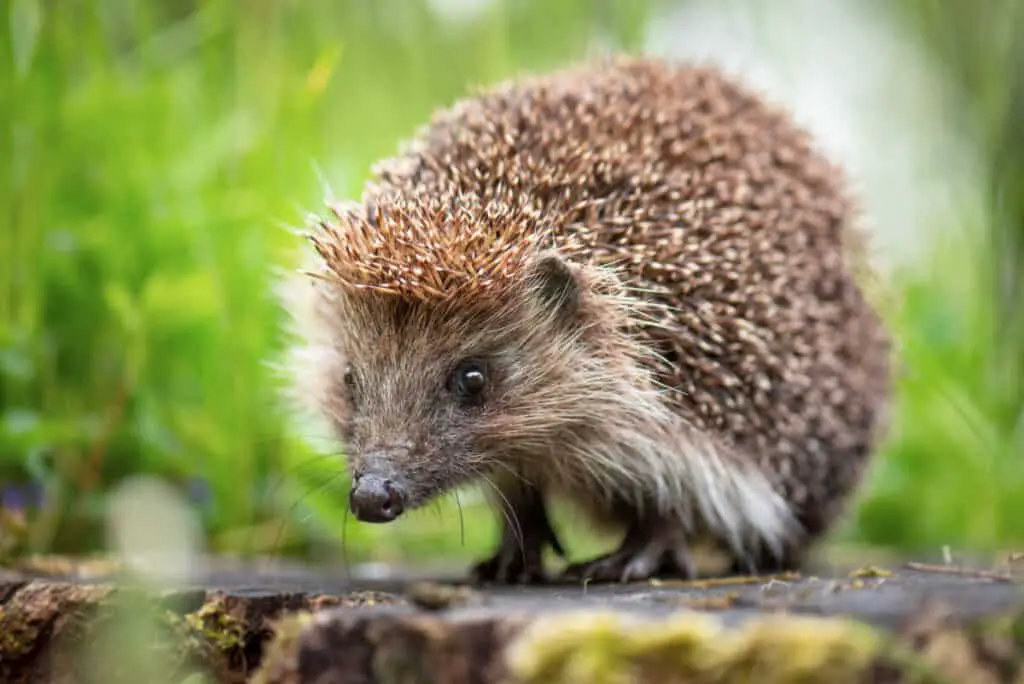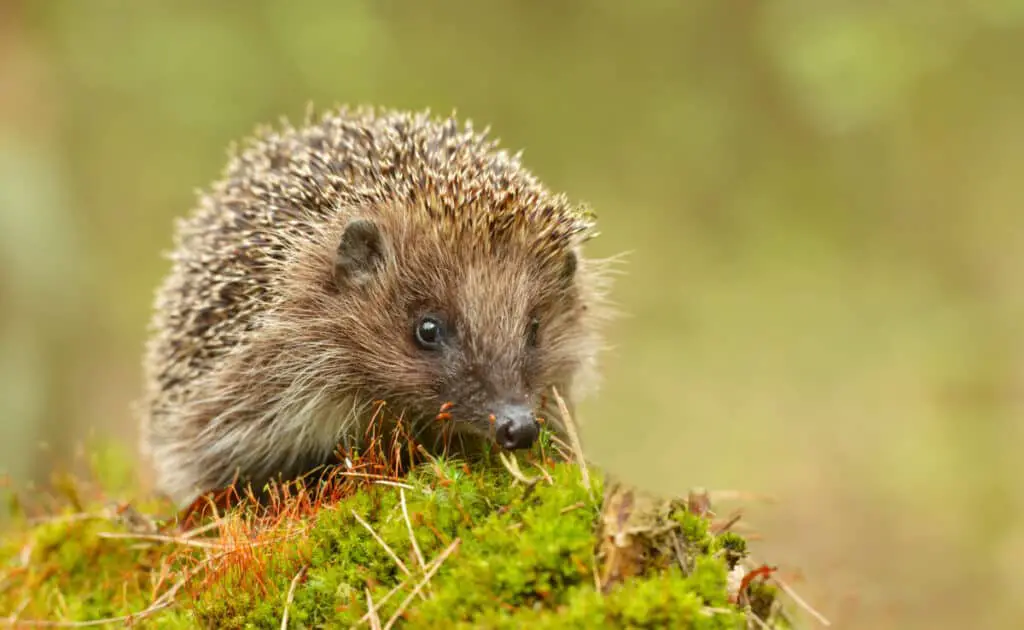Hedgehogs are small, insectivorous mammals that belong to the family Erinaceidae. They are found in Europe, Asia, and Africa.
Hedgehogs have gained global popularity as pets due to their cute appearance and low-maintenance nature.
The hedgehog’s most distinctive feature is its spiny coat which acts as a defensive mechanism against predators. These prickly quills cover the animal’s entire body except for its belly, face, and legs.
The quills are hollow hairs made of keratin – the same protein found in human hair and nails. When threatened or frightened, hedgehogs roll into a tight ball with their head and limbs tucked inside, leaving only the sharp spines exposed to deter potential attackers.
Despite being covered in spikes, hedgehogs do not shoot them out nor throw them at predators like some people believe.

Habitat And Distribution
Found across much of Europe, Asia, and Africa, hedgehogs have an extensive geographical range that spans from the United Kingdom in the west to Iran in the east. Despite this wide distribution, hedgehogs tend to prefer certain environments over others.
They thrive in grasslands and woodlands where they can find ample shelter under logs or bushes during the day. In urban areas, they often take up residence in gardens and parks where there is plenty of cover provided by hedges and shrubs. These environmental adaptations allow them to survive in a variety of settings despite being relatively small and vulnerable animals.
Physical Characteristics
Hedgehogs are known for their adaptability and can thrive in a variety of habitats, including forests, grasslands, deserts, and suburban areas. They are found throughout Europe, Asia, Africa, and New Zealand but are absent from the Americas and Australia. These small mammals have a wide distribution due to their ability to adjust to different environments.
Moving on to the physical characteristics of hedgehogs, they have spiny coats that serve as protection against predators. Although they may look similar to porcupines or echidnas at first glance, hedgehogs belong to a separate family called Erinaceidae. Compared to other spiny mammals like porcupines or echidnas which rely solely on their quills for defense, hedgehogs also possess some unique behavioral tendencies such as rolling into tight balls when threatened. This allows them to protect themselves from potential harm by exposing only their sharp quills outwardly while keeping their vulnerable face and belly protected inside the ball.
Hedgehogs have poor eyesight but excellent hearing abilities. Their diet mainly consists of insects but can include plant matter occasionally. Hedgehog’s average lifespan is 4-7 years in wild conditions. They are solitary creatures who typically come together only during mating season.
In summary, hedgehogs exhibit remarkable adaptive behavior and share similarities with other spiny mammals in terms of their protective coat. However, their unique behavioral tendencies distinguish them from other animals in this group.
Hedgehogs’ Predators Exposed: Unveiling the Threats
Defensive Mechanisms
At first glance, the hedgehog’s spiky appearance may seem like its primary defensive mechanism. However, this is not entirely true. Their sharp quills are used as a deterrent to predators such as foxes and badgers, and when threatened or attacked, hedgehogs will curl up into a tight ball with their quills pointing outwards in all directions.
Additionally, hedgehogs have excellent hearing and smell which allows them to detect predators from a distance. They will often freeze in place or run away if they sense danger approaching. Furthermore, some species of hedgehog have adapted to climb trees or swim across water bodies as an escape route from ground-based predators. By utilizing these various tactics, the hedgehog has been able to survive and thrive despite being relatively small and vulnerable.
| Defensive Mechanisms | Description |
|---|---|
| Curling up into a ball | Hedgehogs can roll themselves into a ball-like shape with their quills facing outwards to protect themselves against threats |
| Excellent senses | The keen sense of hearing and smelling helps them detect potential dangers from afar |
| Adaptability | Some species of hedgehogs are known for climbing trees or swimming across water bodies as an escape route from ground-based predators |
Overall, the spiny exterior of the hedgehog serves more than just an intimidating visual effect; it plays an important role in protecting itself from harm while complemented by other defensive mechanisms that ensure survival under varying conditions.
Diet And Feeding Habits
Hedgehogs are known for their insectivorous diet, but they can also be omnivorous.
In the wild, hedgehogs feed on a variety of insects such as beetles, caterpillars, and earthworms. They may also consume small animals like frogs and even snakes. Hedgehogs have adapted to eat different types of food depending on availability and season.
In captivity, hedgehog owners should provide them with a balanced diet that includes high-quality cat or dog food supplemented with live insects like crickets or mealworms. Fruits and vegetables can also be added in small amounts.
It is important to make sure that the hedgehog’s diet is not too high in fat as this can lead to obesity which can result in health problems such as fatty liver disease. Overall, a well-balanced diet will help keep hedgehogs healthy and happy.
Benefits of feeding an appropriate diet:
- Longer lifespan
- Improved quality of life
- Reduced risk of health issues
- Avoidance of obesity-related diseases
- Better digestive health and regular bowel movements.
Reproduction And Life Cycle
Hedgehogs are small, spiny mammals known for their unique appearance and comical behavior. Their diet primarily consists of insects, snails, worms, and occasionally fruits and vegetables. Hedgehogs have a high metabolism which requires them to eat frequently throughout the day and night. They also require access to fresh water at all times.
Breeding season for hedgehogs typically occurs between May and September in most parts of the world. During this time, male hedgehogs will actively search for females to mate with. The gestation period lasts around 35 days on average, after which the female will give birth to a litter of four to six hoglets.
These young hedgehogs are born blind and without any spikes but quickly develop these features within a few hours of being born. The mother will nurse her offspring until they are old enough to fend for themselves, usually around 6-8 weeks old.
Hedgehog reproduction is an essential aspect of their life cycle as it ensures the continuation of their species. Understanding their breeding habits can aid conservation efforts that aim to protect dwindling populations across various regions globally. As such, more research should be conducted into hedgehog reproductive biology so that we may better understand how best to conserve these fascinating creatures in the wild without interfering too much with their natural processes.
Conservation Status And Threats
The hedgehog (Erinaceus europaeus) is classified as ‘vulnerable’ by the International Union for Conservation of Nature (IUCN). The population decline in Europe has been estimated to be around 30% over the last decade. This decline has predominantly occurred due to habitat loss, fragmentation, and degradation caused by human activities such as urbanization, agricultural intensification, deforestation, and road development.
Human impact on hedgehogs goes beyond just habitat loss; it also involves direct threats like poisoning through pesticides used in agriculture or inadvertently ingesting litter thrown away irresponsibly. Additionally, these animals are often victims of traffic accidents while crossing roads at night in search of food or mates.
Although efforts have been made to address these issues with measures like designing wildlife corridors, reducing pesticide use, encouraging responsible disposal of waste materials and educating people about how they can help protect them – more needs to be done to ensure that the declining trend is reversed soon.
- Habitat loss
- Fragmentation
- Degradation
- Pollution
- Traffic Accidents
are all contributing to the decline in biodiversity, particularly for species that require large areas of habitat to survive. It is important to implement measures such as habitat restoration and conservation to combat these threats and protect our planet’s biodiversity.

Conclusion
The hedgehog is a small mammal found in many parts of the world, including Europe, Asia, and Africa. They are characterized by their spiny exterior and nocturnal habits. Hedgehogs can thrive in a variety of habitats such as forests, grasslands, and farmland.
These fascinating creatures have developed various defensive mechanisms to protect themselves from predators. Their primary defense mechanism is curling into a tight ball with their sharp quills sticking outwards. Hedgehogs are omnivorous animals that feed on insects, fruits, vegetables, and even small vertebrates like frogs.
Despite being widely distributed across the globe, some species of hedgehogs are facing threats due to habitat loss and fragmentation caused by human activities. Some countries have also declared them as pests leading to indiscriminate killing or hunting for meat consumption.
In conclusion, hedgehogs play an essential role in maintaining ecological balance in their respective habitats. Their unique physical characteristics and defensive mechanisms make them intriguing subjects for scientific research while also making them popular pets worldwide.
It is crucial to take necessary measures to conserve their populations so that future generations can witness these amazing animals in the wild.
